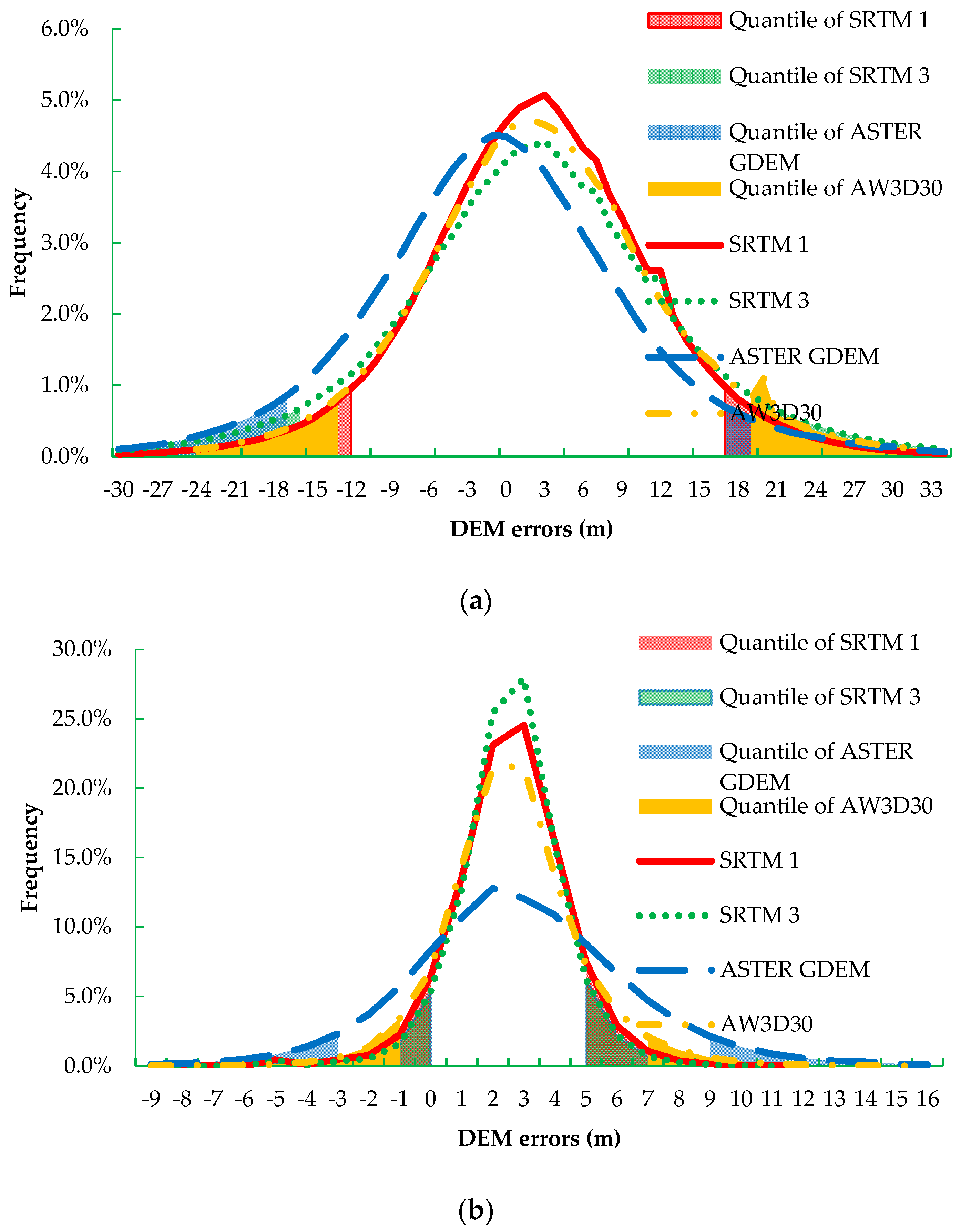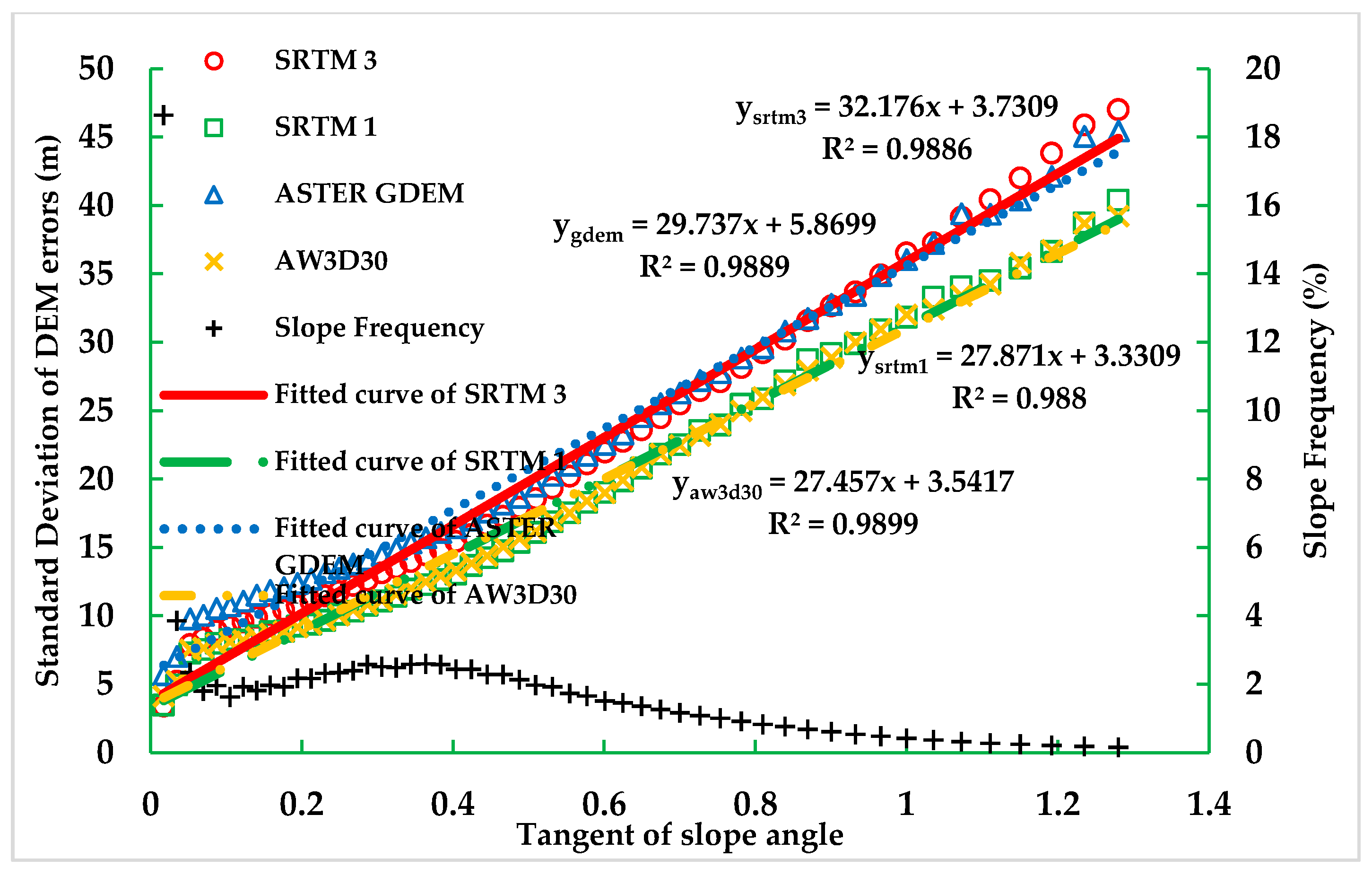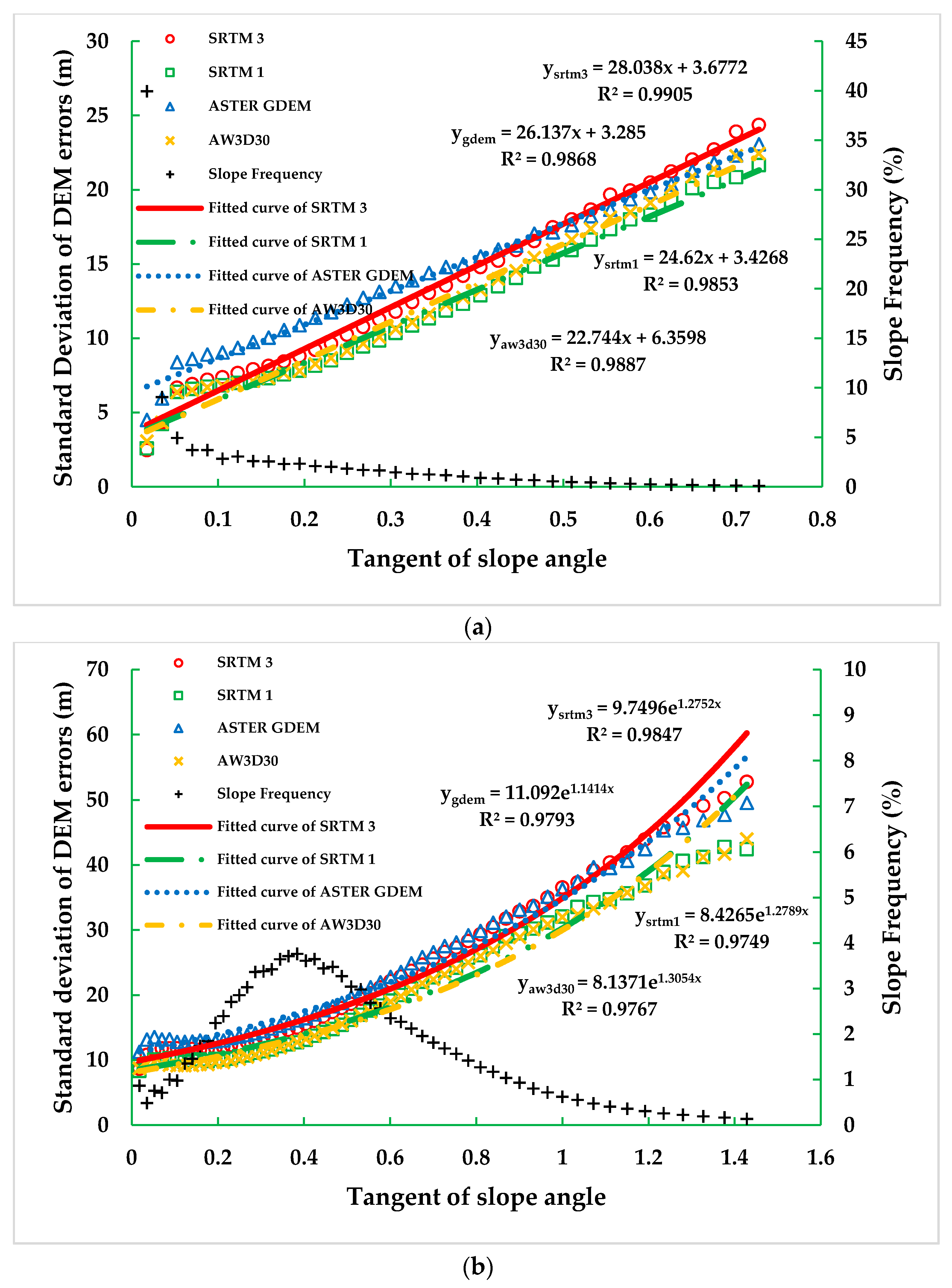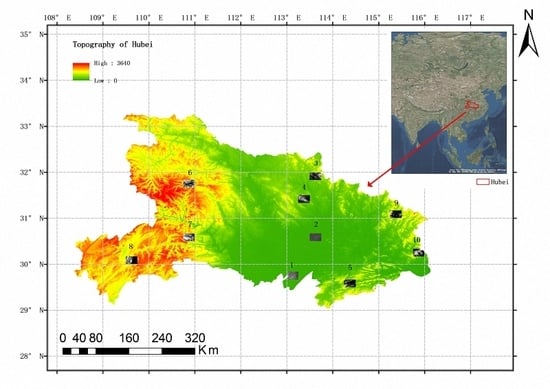Evaluation of Recently Released Open Global Digital Elevation Models of Hubei, China
Abstract
:1. Introduction
2. Study Areas and Reference Data
2.1. Study Areas
2.2. Reference DEM
2.3. 30-Meter Global Land Cover Dataset
3. Methods
3.1. Data Co-Registration
3.2. Validation Methods
4. Results and Discussion
4.1. Overall Accuracy
4.2. Accuracy versus Terrain Slope
4.3. Accuracy versus Land Cover
4.4. Accuracy versus Land Cover and Slope
4.5. Accuracy versus Stack Number
5. Conclusions
Acknowledgments
Author Contributions
Conflicts of Interest
References
- Bolch, T.; Kamp, U.; Olsenholler, J. Using ASTER and SRTM DEMs for Studying Geomorphology and Glaciation in High Mountain Areas; New strategies for European Remote Sensing; Millpress: Rotterdam, The Netherlands, 2005. [Google Scholar]
- Nikolakopoulos, K.; Chrysoulakis, N. Updating the 1:50.000 topographic maps using ASTER and SRTM DEM: The case of Athens, Greece. Int. Soc. Opt. Photon. 2006, 6366, 636606–636611. [Google Scholar]
- Śleszyński, P. Expected traffic speed in Poland using Corine land cover, SRTM-3 and detailed population places data. J. Maps 2014, 11, 245–254. [Google Scholar] [CrossRef]
- Ho, L.; Umitsu, M.; Yamaguchi, Y. Flood hazard mapping by satellite images and SRTM DEM in THE VU GIA–Thu Bon Alluvial Plain, central Vietnam. Netw. World Remote Sens. 2010, 38, 275–280. [Google Scholar]
- Foni, A.; Seal, D. Shuttle Radar Topography Mission: An innovative approach to shuttle orbital control. Acta Astronaut. 2004, 54, 565–570. [Google Scholar] [CrossRef]
- SRTM 90m Digital Elevation Database v4.1. Available online: http://www.cgiar-csi.org/data/srtm-90m-digital-elevation-database-v4-1 (accessed on 5 May 2016).
- SRTM: NASA Shuttle Radar Topography Mission. Available online: http://vterrain.org/Elevation/SRTM (accessed on 5 May 2016).
- ASTER GDEM Validation Team. ASTER Global DEM Validation Summary Report. June 2009. Available online: https://lpdaac.usgs.gov/sites/default/files/public/aster/docs/ASTER_GDEM_Validation_Summary_Report.pdf (accessed on 5 May 2016).
- ASTER Global Digital Elevation Map Announcement. Available online: http://asterweb.jpl.nasa.gov/gdem.asp (accessed on 5 May 2016).
- ALOS Global Digital Surface Model “ALOS World 3D - 30m” (AW3D30). Available online: http://www.eorc.jaxa.jp/ALOS/en/aw3d30/index.htm (accessed on 29 September 2016).
- Takaku, J.; Tadono, T.; Tsutsui, K. Generation of High Resolution Global DSM from ALOS PRISM. In Proceedings of the International Archives of the Photogrammetry, Remote Sensing and Spatial Information Sciences, ISPRS TC IV Symposium, Suzhou, China, 14–16 May 2014; Volume XL-4, pp. 243–248.
- Tadono, T.; Ishida, H.; Oda, F.; Naito, S.; Minakawa, K.; Iwamoto, H. Precise Global DEM Generation by ALOS PRISM. In Proceedings of the ISPRS Annals of the Photogrammetry, Remote Sensing and Spatial Information Sciences, ISPRS TC IV Symposium, Suzhou, China, 14–16 May 2014; Volume II-4, pp. 71–76.
- Sun, G.; Ranson, K.; Kharuk, V.; Kovacs, K. Validation of surface height from Shuttle Radar Topography Mission using shuttle laser altimeter. Remote Sens. Environ. 2003, 4, 401–411. [Google Scholar] [CrossRef]
- Zhan, L.; Tang, G.; Yang, X. Evaluation of SRTM DEMs’ Elevation Accuracy: A Case Study in Shanxi Province. Geogr. Geo-Inf. Sci. 2010, 26, 34–36. (In Chinese) [Google Scholar]
- Wong, W.V.; Tsuyuki, S.; Loki, K.; Phua, M.H. Accuracy assessment of global topographic data (SRTM & ASTER GDEM) in comparison with LIDAR for tropical montane forest. In Proceedings of the 35th Asian Conference on Remote Sensing, Nay Pyi Taw, Myanmar, 27–31 October 2014; pp. 722–727.
- Mukherjee, S.; Joshi, P.; Mukherjee, S.; Ghosh, A.; Garg, R.; Mukhopadhyay, A. Evaluation of vertical accuracy of open source Digital Elevation Model (DEM). Int. J. Appl. Earth Obs. Geoinf. 2013, 21, 205–217. [Google Scholar] [CrossRef]
- Athmania, D.; Achour, H. External Validation of the ASTER GDEM2, GMTED2010 and CGIAR-CSI- SRTM v4.1 Free Access Digital Elevation Models (DEMs) in Tunisia and Algeria. Remote Sens. 2014, 6, 4600–4620. [Google Scholar] [CrossRef]
- Chaieb, A.; Rebai, N.; Bouaziz, S. Vertical Accuracy Assessment of SRTM Ver 4.1 and ASTER GDEM Ver 2 Using GPS Measurements in Central West of Tunisia. J. Geogr. Inf. Syst. 2016, 8, 57–64. [Google Scholar] [CrossRef]
- Miliaresis, G.C.; Paraschou, C.V.E. Vertical accuracy of the SRTM DTED level 1 of Crete. Int. J. Appl. Earth Obs. Geoinfor. 2005, 7, 49–59. [Google Scholar] [CrossRef]
- Abrams, M.; Bailey, B.; Tsu, H.; Hato, M. The ASTER global DEM. Photogramm. Eng. Remote Sens. 2010, 76, 344–348. [Google Scholar]
- Miliaresis, G.C.; Paraschou, C.V.E. An evaluation of the accuracy of the ASTER GDEM and the role of stack number: A case study of Nisiros Island, Greece. Remote Sens. Lett. 2011, 2, 127–135. [Google Scholar] [CrossRef]
- Suwandana, E.; Kawamura, K.; Sakuno, Y.; Kustiyanto, E.; Raharjo, B. Evaluation of ASTER GDEM2 in comparison with GDEM1, SRTM DEM and topographic-map-derived DEM using inundation area analysis and RTK-dGPS data. Remote Sens. 2012, 4, 2419–2431. [Google Scholar] [CrossRef]
- Rexer, M.; Hirt, C. Comparison of free high resolution digital elevation data sets (ASTER GDEM2, SRTM v2.1/v4.1) and validation against accurate heights from the Australian National Gravity Database. Aust. J. Earth Sci. 2014, 61, 213–226. [Google Scholar] [CrossRef]
- Mukul, M.; Srivastava, V.; Mukul, M. Accuracy analysis of the 2014–2015 Global Shuttle Radar Topography Mission (SRTM) 1 arc-sec C-Band height model using International Global Navigation Satellite System Service (IGS) Network. J. Earth Syst. Sci. 2016, 125, 909–917. [Google Scholar] [CrossRef]
- Li, P.; Shi, C.; Li, Z.; Muller, J.; Drummond, J.; Li, X.; Li, T.; Li, Y.; Liu, J. Evaluation of ASTER GDEM VER2 using GPS measurements and SRTM VER4.1 in China. ISPRS Ann. Photogramm. Remote Sens. Spat. Inf. Sci. 2012, i-4, 181–186. [Google Scholar] [CrossRef]
- Purinton, B.; Bookhagen, B. Processing, validating, and comparing DEMs for geomorphic application on the Puna de Atacama Plateau, northwest Argentina. In Proceedings of the EGU General Assembly Conference, Vienna, Austria, 17–22 April 2016; p. 2806.
- Santillan, J.; Makinano, M. Vertical Accuracy Assessment of 30-M Resolution Alos, Aster, and Srtm Global Dems over Northeastern Mindanao, Philippines. ISPRS Int. Arch. Photogramm. Remote Sens. Spat. Inf. Sci. 2016, XLI-B4, 149–156. [Google Scholar] [CrossRef]
- Chen, J.; Liao, A.; Cao, X.; Chen, L.; Chen, X.; Peng, S.; Han, G.; Zhang, H.; He, C.; et al. Concepts and Key Techniques for 30m Global Land Cover Mapping. Acta Geod. Cartogr. Sin. 2014, 43, 551–557. (In Chinese) [Google Scholar]
- General Administration of Quality Supervision, Inspection and Quarantine of the People's Republic of China, Standardization Administration of the People's Republic of China. In GB/T 17157–2012, Specifications for Aerial Photogrammetric Digital Mapping of 1:25,000, 1:50,000 and 1:10,000 Topographic Maps; Standards Press of China: Beijing, China, 2012. (In Chinese)
- Brovelli, M.; Molinari, M.; Hussein, E.; Chen, J.; Li, R. The First Comprehensive Accuracy Assessment of GlobeLand30 at a National Level: Methodology and Results. Remote Sens. 2015, 7, 4191–4212. [Google Scholar] [CrossRef] [Green Version]
- Guo, H.; Jiao, W.; Yang, Y. The systematic Difference and Its Distribution between the 1985 National Height Datum and the Global Quasigeoid. Acta Geod. Cartogr. Sin. 2004, 33, 100–104. (In Chinese) [Google Scholar]
- Guo, X.; Zhang, H.; Zhang, Z.; Hou, G.; Zhao, J. Comparative Analysis of the Quality and Accuracy between ASTER-GDEM and SRTM 3. Remote Sens. Technol. Appl. 2011, 26, 334–339. (In Chinese) [Google Scholar]
- Besl, P.; Mckay, N. A method of registration of 3-D shapes. IEEE Trans. Pattern Anal. Mach. Intell. 1992, 14, 239–256. [Google Scholar] [CrossRef]
- SRTM_Topo. Available online: https://dds.cr.usgs.gov/srtm/version1/Documentation/SRTM_Topo.txt (accessed on 23 December 2016).
- Gorokhovich, Y.; Voustianiouk, A. Accuracy assessment of the processed SRTM-based elevation data by CGIAR using field data from USA and Thailand and its relation to the terrain characteristic. Remote Sens. Environ. 2006, 104, 409–415. [Google Scholar] [CrossRef]
- Kenyi, L.; Dubayah, R.; Hofton, M.; Blair, J.; Schardt, M. Comparison of SRTM-NED data to LIDAR derived canopy metrics. In Proceedings of the IEEE International Geoscience and Remote Sensing Symposium, Barcelona, Spain, 23–28 July 2007; pp. 2825–2829.
- Rodriguez, E.; Morris, C.; Belz, J. A global assessment of the SRTM performance. Photogramm. Eng. Remote Sens. 2006, 72, 249–260. [Google Scholar] [CrossRef]







| SRTM 3 | SRTM 1 | ASTER GDEM | AW3D30 | |
|---|---|---|---|---|
| Acquisition Years | 2000 | 2000 | Since 1999 | 2006 to 2011 |
| Released Years | 2003 | Since 2015 outside US | 2009 | 2016 |
| Agency | NASA | NASA | NASA and METI | JAXA |
| Coverage | 60°N to 56°S | 60°N to 56°S | 83°N to 83°S | 82°N to 82°S |
| Resolution | 3” | 1” | 1” | 1” |
| Sensor | Shuttle Radar | Shuttle Radar | ASTER | PRISM |
| Method | InSAR | InSAR | Stereo matching | Stereo matching |
| Nominal Vertical Accuracy | 16 m | 16 m | 20 m | Unknown; however, 5 m for the 5-m mesh |
| Nominal Horizontal Accuracy | 20 m | 20 m | 30 m | |
| Website | http://earthexplorer.usgs.gov/ | http://www.eorc.jaxa.jp/ALOS/en/aw3d30/data/index.htm | ||
| DEM | South-North | West-East |
|---|---|---|
| SRTM 3 | −0.20 ± 0.57 | 0.39 ± 0.74 |
| SRTM 1 | 0.04 ± 0.84 | −0.01 ± 0.67 |
| ASTER-GDEM | −0.44 ± 0.65 | −0.59 ± 0.71 |
| AW3D30 | 0.08 ± 0.68 | −0.12 ± 0.69 |
| DEM | Plain | Hill | Mountain | |||
|---|---|---|---|---|---|---|
| Mean | Std. | Mean | Std. | Mean | Std. | |
| SRTM 3 | 2.6 | 1.7 | 2.4 | 11.3 | 1.5 | 21.3 |
| SRTM 1 | 2.6 | 1.9 | 2.6 | 9.1 | 1.1 | 18.6 |
| ASTER GDEM | 2.9 | 4.2 | −0.4 | 10.8 | 4.7 | 23.2 |
| AW3D30 | 2.6 | 2.3 | 2.9 | 9.9 | 2.6 | 18.9 |
© 2017 by the authors. Licensee MDPI, Basel, Switzerland. This article is an open access article distributed under the terms and conditions of the Creative Commons Attribution (CC BY) license ( http://creativecommons.org/licenses/by/4.0/).
Share and Cite
Hu, Z.; Peng, J.; Hou, Y.; Shan, J. Evaluation of Recently Released Open Global Digital Elevation Models of Hubei, China. Remote Sens. 2017, 9, 262. https://doi.org/10.3390/rs9030262
Hu Z, Peng J, Hou Y, Shan J. Evaluation of Recently Released Open Global Digital Elevation Models of Hubei, China. Remote Sensing. 2017; 9(3):262. https://doi.org/10.3390/rs9030262
Chicago/Turabian StyleHu, Zhihua, Jianwei Peng, Yaolin Hou, and Jie Shan. 2017. "Evaluation of Recently Released Open Global Digital Elevation Models of Hubei, China" Remote Sensing 9, no. 3: 262. https://doi.org/10.3390/rs9030262







